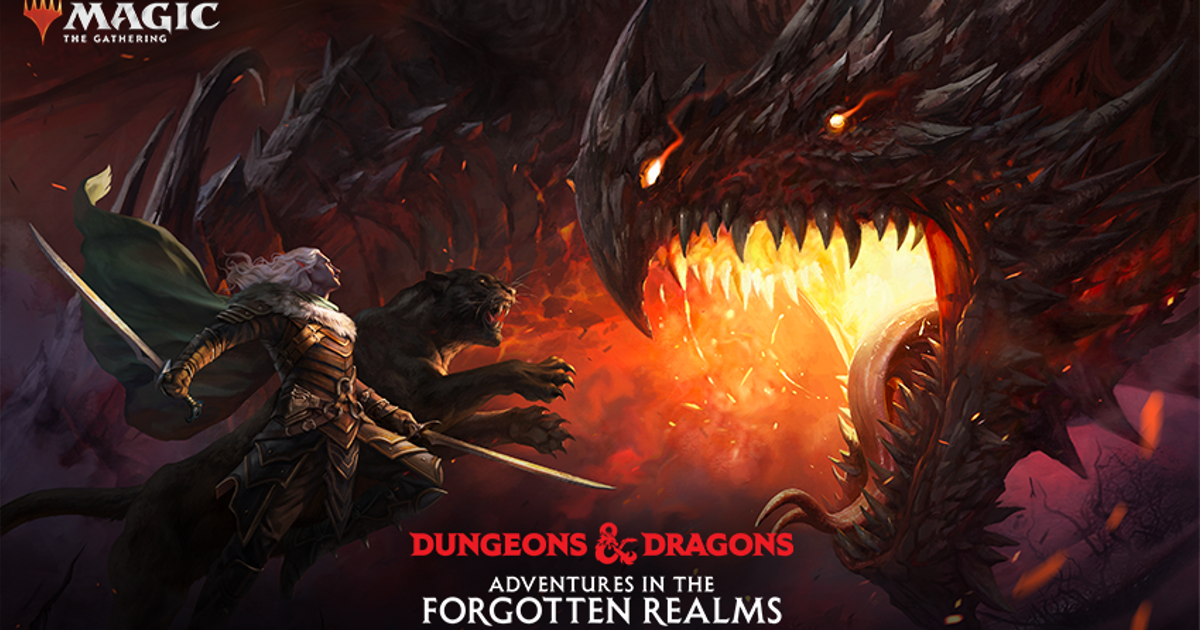At San Diego Comic-Con last Saturday, Magic: The Gathering head designer Mark Rosewater and lead designer Jules Robins shared a pre-recorded conversation where they talked about the key controversies that came along with the development of the new Dungeons & Dragons crossover set, Adventures in the Forgotten Realms, which was just released last Friday.
You can watch the MTG Comic-Con panel embedded below:
They explained why it took so long for MTG and D&D to cross-over in such a major way —and what it took to finally make it happen after decades. "In 1998, Wizards of the Coast purchased TSR [Gary Gigax's original tabletop company that published Dungeons & Dragons]... and one of the big worries at the time when we bought the company was, both of our big properties were fantasy properties, and we were a little bit worried that they might get confused with one another," Rosewater said.
There was a fear to put together Wizards' two biggest fantasy properties. "Don't cross the streams," Rosewater said. "Originally, the idea was let Magic be Magic and let Dungeons & Dragons be Dungeons & Dragons, and really for many years we kept them apart."
Wizards of the Coast's sourcebook writer James Wyatt led an effort to make free-to-download D&D sourcebooks based on popular Magic sets — Plane Shift: Amonkhet, Planeshift: Innistrad, and Planeshift: Kaladesh. Then Wizards published full-priced physical and digital sourcebooks with Guildmaster's Guide to Ravnica, Mythic Odysseys of Theros, and Strixhaven: Curriculum of Chaos (which is set to release on Nov. 16).
Later, Aaron Forsythe, vice president of Magic design, came up with the idea of Universes Beyond, the collaborative effort to create Magic cards based on the lore of different IPs. J.R.R. Tolkien's The Lord of the Rings and Warhammer 40,000 will have new sets in that initiative, and the idea of crossing-over with D&D quickly came up in their conversation.
"What if other IPs appeared on Magic cards?" Rosewater said. "Once that conversation got going, one of the things that came up really quickly was, well, why not Dungeons & Dragons?"
However, it was still a learning experience for the team to add the elements of D&D to the crossover set.
"At the very start, we were like ‘Alright, we've got Core Set 2021 the year before, and this'll be Core Set 2022'," Robins explained. "Instead of a different [Magic] mechanic returning, it'll be a Dungeons & Dragons setting... we started in on that, we made a bunch of simple Magic cards capturing elements of [the setting], and it just felt too much like a normal Magic set, and didn't reward people who were long-time D&D fans... it felt like it wasn't paying off enough."
After establishing that the crossover set would take place in the world of Forgotten Realms, the Magic design team experimented with different mechanics to incorporate as many D&D trappines as possible — from new enchantment cards that let players adopt a D&D class, to cards with dice-rolling mechanics, and cards that allow players to "venture into a dungeon".
After the design team experimented with playtesters, the team concluded that it wasn't necessarily D&D's game rules that needed to be brought into MTG. "The throughline [from player feedback] was that we needed to capture the ethos of D&D," Robins said.
"The reading and playing of these cards needed to feel like the emotions that you have surrounding Dungeons & Dragons." Rosewater explained, "It was okay if it played like Magic, but it had to be really evocative—it had to feel like D&D."
Robins also revealed that the dungeon mechanic was initially intended to comprise a second, separate deck or cards. "Every so often you'd be about to move your marker and explore a new room and try to figure out where you were going in this dungeon as it spawned," Robins explained. However, Rosewater explained that it didn't work out due to the high variance.
The design team ended up making three dungeon cards that players can choose from when they first play a card with the "venture" keyword.
As for cards that ask you to roll a D20, the designers explained how some of the initial designs made games more dependent on the outcome of the dice rolls, and Rosewater said that the team didn't want Magic to rely on that. "When we were playtesting the die cards, die rolling was very polarizing," said Rosewater.
Related: MTG Arena's New Set Jumpstart: Historic Horizons Mechanics Revealed
After about three decades, Magic and D&D have finally crossed the streams with the release of Adventures in the Forgotten Realms, and fans of both franchises are enjoying the crossover even though some players are not happy about the upcoming Universes Beyond sets. However, WotC is making a major change to appease fan criticisms.
Dungeons & Dragons: Adventures in the Forgotten Realms is now available for tabletop and digitally via MTG Arena and Magic Online.
Explore new topics and discover content that's right for you!
Magic: the Gathering






